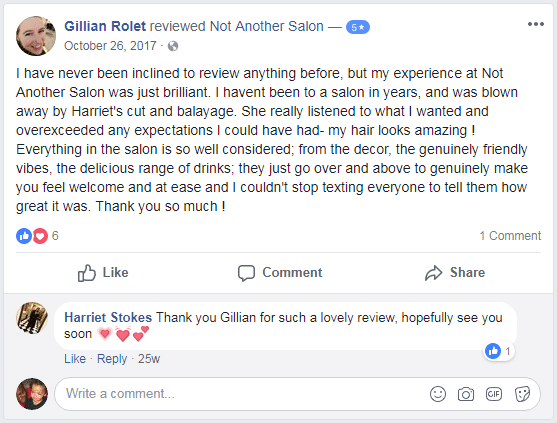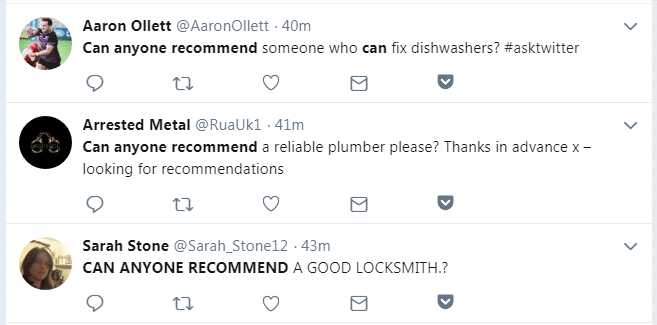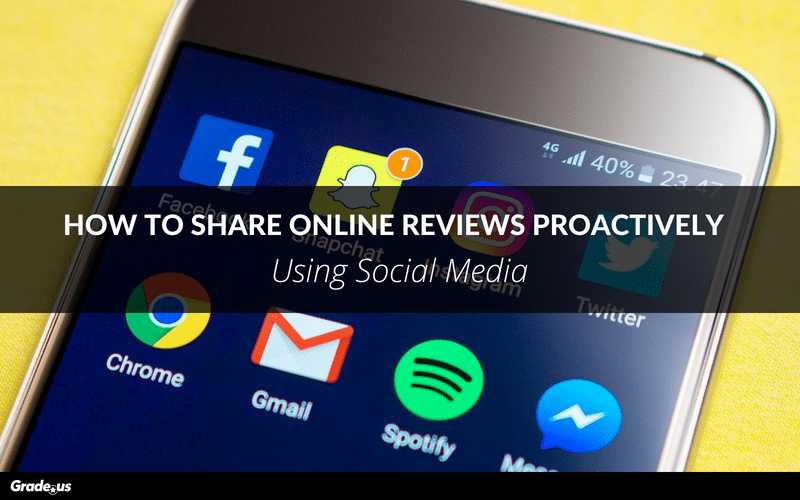Reviews are kingmakers.
You know it, I know it. Share online reviews on the right platforms and you attract an enormous wave of attention. Get customers to promote your reviews within their sphere of influence and you extend your reach exponentially.
But how?
By sharing your online reviews with customers! There's more to it than that, however.
Sharing allows you to hijack context
The word "hijack" sounds yucky.
That's because reviews are often treated as window dressing or used as an ambush tool. When it's used to ambush, it's sleazy and gross. As window dressing it's easy to ignore. Either case minimizes the impact a potential review can have.
What's the cause?
Reviews are often reactive. We count on customers to seek out the reviews they want to see. What if we didn't? What if we brought reviews to customers at a relevant and contextually appropriate time?
The results could be phenomenal.
Here's the thing though. When we hijack context we're not taking away a reviewer or customer's ability to choose. We're not badgering people with our reviews. We're also not behaving unethically.
We're using relevance to provide more options.
Relevance protects you from unexpected backlash
Relevance is a lot like a traffic light.
It tells you when to approach customers with your pitch, how to present your reviews and when to be quiet. It's as simple as matching their situation to your review.
· Are customers asking for help? Confirm their problem, share your solution, then present your relevant reviews.
· Looking to reach out to past visitors? Use tweets, status updates or messages as a platform to share recent reviews.
· Have customers raised legitimate objections? Use specific reviews, that are relevant to their situation, to defuse objections permanently.
It's a bit different.
It's not really all that common to see reviews used proactively, which is why social media sharing is so important. When you proactively share online reviews with your customers you're able to:
· Initiate or spark online discussion. A positive review can spark discussions where customers swap stories with each other about their experiences with your organization.
· Preemptively defuse objections, reduce risk and decrease customer fear. Seeding conversations with positive (and sometimes negative) reviews at an appropriate time gives you a chance to defuse objections before they become a problem.
· Drive traffic, leads and sales. Most customers are lurkers. Sharing your online reviews with potential customers gives them an opportunity to assess your business discreetly.
· Increase conversion rates. Research consistently shows online reviews have a dramatic effect on your conversion rates. The lift from online reviews can increase conversion rates by as much as 270 percent!
· Cultivate review virality. Social networks like LinkedIn and Facebook have virality built-in. When you like a status update, add comments, share photos and videos, your friends see your activity in their feed. Cross pollinating reviews (i.e. sharing Facebook reviews on LinkedIn) gives you an opportunity to attract a consistent stream of attention.
· Identify and segment customer evangelists. Sharing your online reviews gives your customers the chance to chime in with additional thoughts and feedback. It gives you another opportunity to express your gratitude and thanks. Most importantly, it gives your very best customers a chance to self-identify.
If you're looking to generate more revenue, sharing online reviews is an important and valuable strategy.
But how?
Which social media sites allow you to share your customer reviews? More importantly, what's the best way to share online reviews with customers?
Why sharing reviews can be a disaster
It's important that you approach customers the right way. If you're not really sure how to share your online reviews you could be headed for trouble.
Okay, how do you share reviews with customers?
· Respond to your customers. Thank them for sharing their reviews. Chat them up. Quote and/or reply to your customer's review, status update, tweet or message.

Remember, when you like a status update, add comments or share photos and videos, your friends see your activity in their feed.
· Embed reviews, tweets and status updates on conversion gateways. Embed reviews on landing, sales and promo pages. Post review requests on confirmation pages. Embed reviews directly below your requests.
Here's an example from Yelp
And one from Facebook
Handled well, your embeds give you the ability to engage with customers on your site. But, they also give customers the ability to interact with your reviews. A like, comment or share on your embedded review cultivates virality, putting your business in front of even more customers.
· Respond to queries. Customers use platforms like Twitter or LinkedIn to request recommendations on a regular basis. This is an appropriate place to share a few specific things (a.) a link to your reviews or review portfolio (b.) your irresistible offer and (c.) a tasteful call-to-action.

You can use a tool like Hootsuite to monitor keywords, mentions, searches and more. When you come across someone looking for a recommendation, be cool. Avoid any hard sell or sleazy sales tactics.
· Brag about your customers. If it's appropriate to do so, talk up their accomplishments, share their wins and success stories. Show customers you're proud of them. That you're happy they're on board with you. That you're rooting for them.
Bragging isn't a review.
But it is a great way for you to build a genuine relationship with each of your customers. If it's appropriate to do so, and your customers are open to it at some point in the future, you can ask for feedback.
But tread carefully.
Ask for reviews at the wrong time or in the wrong way and you destroy all of the goodwill you've built up.
Okay then.
Where do you share these online reviews?
1. Facebook. With more than 2.19 billion active users Facebook is the world's most popular social network. Facebook is filled with a variety of people, groups, brands and causes. If you're looking to share online reviews your organizations should start here. The reason? Virality. It's easy to spread a idea, update or meme rapidly on their platform using profiles, pages and groups.
2. Yelp has an engaged community of 145 million dedicated reviewers. This can be helpful in the right hands. But as Yelp reviewers have shown, this needs to be handled carefully. Make the wrong moves, provide your customers with poor service and their community responds aggressively. Sharing mechanisms allow you to cross pollinate reviews via Facebook, Twitter and email.
3. LinkedIn. As of January 1, 2018, LinkedIn has 500 million users. These users are all focused on business so their platform is ideal for B2B. LinkedIn users aren't all that interested in personal or political updates. The community has its own etiquette and norms. While LinkedIn doesn't offer reviews, it does offer organizations the ability share content via profiles and groups.
4. Twitter has 330 million active users. But unlike the other platforms, where posts, messages and updates are structured and spaced apart. Twitter's messaging is constant. It's like drinking from a fire hose. The content is essentially a never-ending digital stream of consciousness, which is both appealing and unappealing. What makes Twitter special? The ability to search for users in real time. This gives you the ability to instantly identify users who are interested in your product or service.
5. Niche / specialty sites. Some industry specific sites may allow you to share reviews directly via Facebook, Twitter and email. Others may not. It's important to identify the sites and platforms that best meet your needs. It's a low tech option, but screenshots are great ways to share reviews with customers. You can drop the images into your profiles and sites directly or you can use image hosting tools like Imgur or Pinterest.
Did you catch the pattern?
I focused primarily on mainstream social media sites. These sites provide you with the control, access and reach you need to create leverage with your reviews. Used well, these sites can attract a significant amount of attention in a short period of time.
There's a downside to all this.
Sharing online reviews with customers could backfire
Imagine that you're dealing with a repeat customer. Someone who gave your organization a glowing, five-star review in the past.
Only this time they're unhappy.
Sharing their online review comes with considerable risk. Using the strategies and tactics I've covered today - they also come with considerable risk.
It's likely to backfire.
It's a good idea to reach out to customers, to send them through a system or platform that provides (a.) sentiment analysis (e.g. are customers happy or angry with you?) (.b) gives you a chance to convert unhappy reviews into glowing, five-star reviews and (c.) follows up to verify customers are happy and satisfied .
Sharing online reviews gives you exponential reach
But, only if they're shared properly.
Your reviews shouldn't be treated as window dressing. They shouldn't be used as an ambush tool. Your reviews are kingmakers. Sharing them with customers and potential customers expands your sphere of influence and your reach exponentially.
This works if you're proactive.
We typically expect customers to hunt for reviews. What if we didn't? What if we used our online reviews to start a conversation or initiate a relationship?
It's easy-to-do.
Just use relevance. Use relevance as your traffic light to approach, pitch and present your reviews and you'll find customers are eager to read what you have to share.
About the Author
Andrew McDermott
Andrew McDermott is the co-founder of HooktoWin. He shows entrepreneurs how to attract and win new customers.











